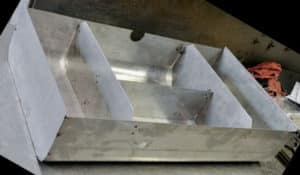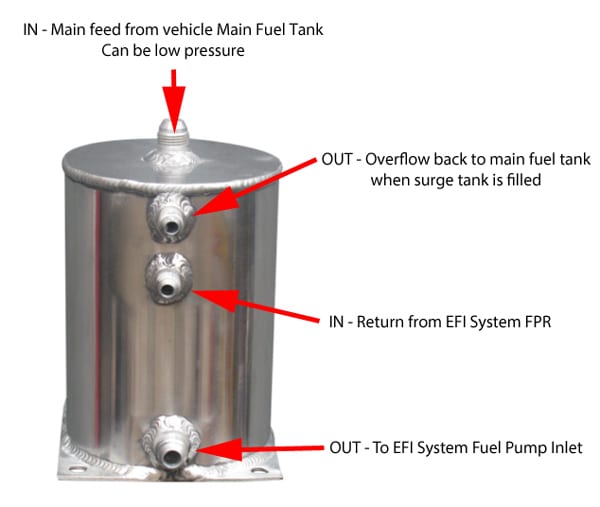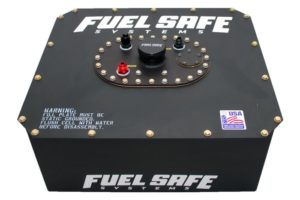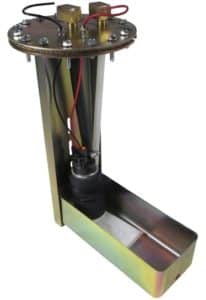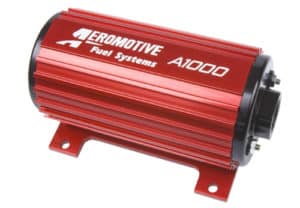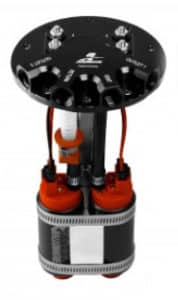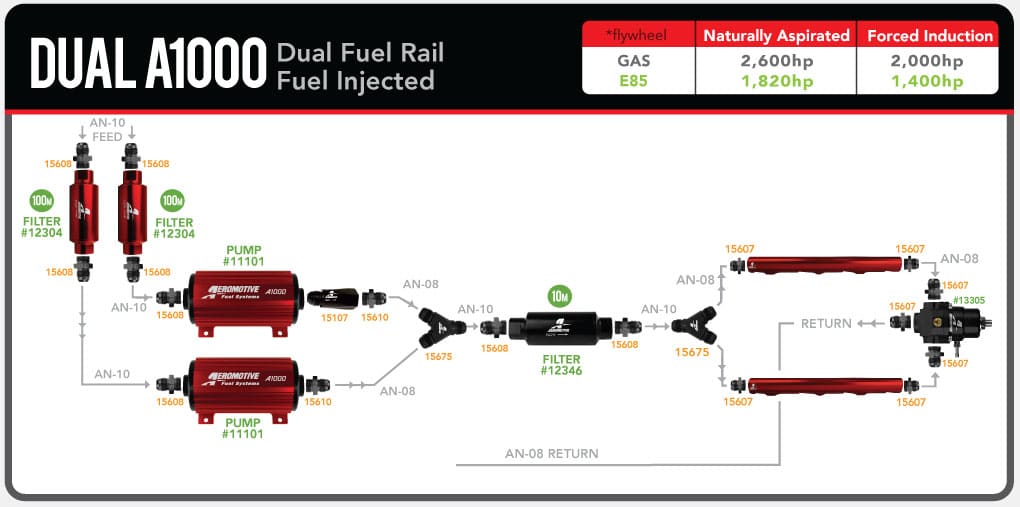Updated October 2022 by Jerry Hoffmann
Chapter 5B – Understanding the Electronic Fuel Injection / EFI Fuel System: EFI Fuel Tanks and Pumps
Start at the beginning – The EFI Fuel Tank
Obviously perhaps, the fuel tank is where it all starts. Ultimately, it needs to store the fuel in a manner that will not allow the fuel to corrode the tank, fittings, and any bladder or foam that may be inside. And it needs to make this fuel available, at any time and under any conditions (cornering, braking, etc) that the vehicle will operate under. Some of you will be able to use what you have as it is, others will need to make a few changes, and a few of you will be starting from scratch. Never fear! We got you!
Fuel Tank options for the Factory EFI Takeover Crew
What? Why are we even talking about this? You’ve already got a modern EFI ready Fuel Tank!!! 😉
So yeah, in most cases, you’re likely just using what’s already there. No need to re-invent the wheel. In most cases you can upgrade the size of the factory in-tank fuel pump with readily available aftermarket fuel pumps that will drop right in. That will meet the needs of many for even some moderately wild setups. If you’re going extra-large on the power goals and getting really wild, you may be looking at other options. Perhaps using an external fuel pump, or pumps, or even using a surge tank and just using the stock pump and return line to keep the surge tank filled, with the big pump between the surge tank and the engine. We’ll talk more on that here in a few paragraphs….
Fuel Tank options for a Carb-To-EFI Conversion
A fuel tank intended for use in a carb’d vehicle can often be adapted for use in a EFI application. You need to look at what’s there, and see what’s missing, and make up for the deficit, right?
What’s there? Typically a tank of course, a fuel outlet, and a fuel sending unit. Sometimes a second tube for a charcoal canister. That’s it.
What’s missing? A fuel return and maybe some baffling. At it’s simplest, that’s all. There are multiple ways you can go about solving the fuel return problem. In order to keep the main body of this chapter from getting too long, where needed I’m going to break out some of these options into greater detail in some smaller addendum/appendix articles. As for baffling in the factory carb’d tank– it’s pretty much either there, or it’s not. You’re not likely to go welding on 50 year old fuel tank with good (or safe) results. For normal usage on a street rod, that’ll probably be just fine. If you’re going racing, well… check out the ‘going racing’ section just below.
For the DIYer that wants to reuse what you’ve got on hand and fit the factory fuel tank with a return line for EFI use, here are a couple options: Modifying a carbureted vehicle factory fuel tank to add a return or feed line for EFI
That appendix covers arguably the best two DIY Carb-To-EFI options to allow you to continue to use the factory fuel tank.
Direct Fit EFI-Ready Fuel Tanks
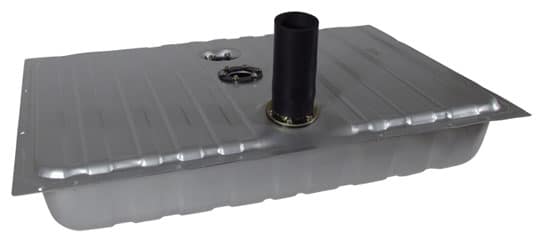
Alternately, you can in many cases buy a fuel tank that’s designed to directly fit your classic car, that is designed for EFI from the get-go. This is the cleanest option by far, it just costs a little more. The benefits are many. Aside from the fact you’ll have a brand new fuel tank replacing your old and busted dirty and rusted tank, a direct fit aftermarket EFI fuel tank for your classic car will also likely fit a fuel pump internally just like a modern EFI fuel tank would. This typically does a great job of pumping fuel (which requires a little thought when using an external pump to ensure the pump is gravity fed fuel). Another BIG benefit to call out– being inside the tank will make the fuel pump far quieter in the passenger compartment. Some of those external pumps can be LOUD! Chances are (and you can ask the manufacturer) these tanks will often be baffled or sumped, or both to help prevent fuel from sloshing away from the pickup under high-G forces.
Baffles and Sumps
Commonly that stock fuel tank from a classic car is pretty simple internally. It’s just a tank. A big open space internally to store fuel, with a pickup at a low point somewhere. There are no chambers or internal walls to help to ensure that fuel doesn’t slosh away from the pickup. Carbureted vehicles are pretty tolerant of this. The float bowl doesn’t run dry if the pickup in the tank does for a second, and it masks any impact that fuel slosh has and prevents it from impacting how the vehicle drives in most cases.
An EFI vehicle however, if the pickup goes dry even for a moment, will see reduced fuel pressure at the injectors, or possibly even no fuel available if the G Forces are severe enough and the tank is maybe low on fuel, allowing all of it to slosh away from the pickup.
This is an easy problem to fix, and another reason to consider retrofitting an aftermarket EFI-ready fuel tank or cell. Baffling essentially creates some chambers inside of the tank that prevent, or really just slow, fuel from moving from one chamber to another. Picture a box around the fuel pickup area that has a number of small-ish holes in it, allowing fuel to move in and out between that chamber and the rest of the fuel tank, BUT, not allowing ALL of the fuel to suddenly escape that chamber. The baffling creates a chamber that is unlikely to allow fuel starvation at the pickup. Fuel cannot move from one chamber to another rapidly when entering a sudden corner, or braking hard, or accelerating down the drag strip when the light turns green. And the pickup never runs dry.
A sump is a similar concept, but rather than using baffles, it essentially involves a fuel tank designed with a ‘low point’ for fuel to sit in and for the pickup to draw fuel from. While better than a wide open flat-bottom tank, some baffling would still be beneficial.
Surge Tanks
A Surge Tank, also sometimes called a ‘Swirl Pot’, is a Secondary Fuel Tank that’s designed to prevent fuel starvation when cornering, accelerating, or decelerating aggressively, even if your main tank has poor baffling or is low on fuel.
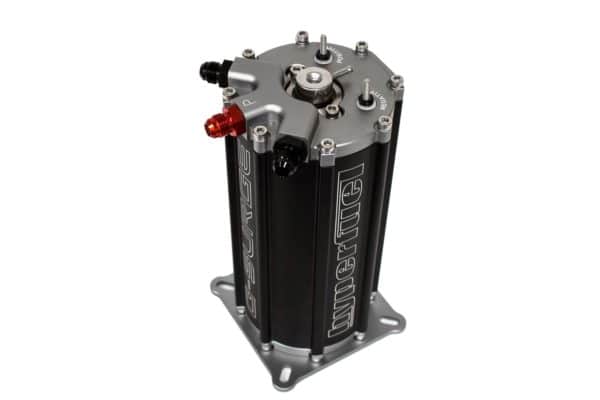
Notice how this design is tall and narrow, that means there really nowhere for the fuel to slosh to which allows the pump a great place to pickup fuel to reduce the risk of running dry. BUT–it’s got a small overall capacity and has to be continually replenished from the main fuel tank.
A surge tank is commonly mounted under the hood (but doesn’t have to be) and is much smaller than the main fuel tank. It is generally taller than it is wide, and can be box shaped or cylindrical. It can use an internal or external fuel pump.
You could almost think of it like ‘outsourcing your baffling/sump’ from the main fuel tank. Using a small, tall, narrow tank– that is being constantly refilled by the main fuel tank/pump, you can be pretty sure that you’ll ALWAYS have fuel available for the pump to pickup so long as the main tank doesn’t go fully dry. It’s sortof like a large float bowl in a carburetor, a very large one in comparison.
This may be the best way to illustrate how a simple surge tank can look. You’ve got a cylinder, taller than it is wide, creating a sump with a fuel pickup at the bottom to feed your EFI Fuel System. The fuel pressure regulator returns fuel back to the lower of the two ports on the side of the tank. Fuel level in the surge tank is maintained by fuel from the main fuel tank being pumped into the top fitting, and once filled, overflowing out of the upper of the two side fittings, back to the main fuel tank. There’s no need for the main feed from the fuel tank to be high pressure, it can be low pressure, possibly even using the stock fuel pump to feed it! You will need a return fitted to the main fuel tank for overflow.
Going Racing
In either case, Factory EFI or Carb Conversion, there comes a time when you must consider a racing fuel cell with safety features like internal bladders that contain the fuel in the event of an accident if the cell itself is damaged, and special vents that provide no-spill rollover protection. Other features like extensive baffling and even internal foam to reduce fuel sloshing around under heavy G Forces are essential depending on the intended use of the vehicle. Companies like ATL and Fuel Safe provide some great options here.
So that accounts for the fuel storage, now you’ve got to get it to your engine! There are a broad variety of options for racing fuel pumps, filters, regulators, etc. Here at DIYAutoTune we carry Aeromotive Fuel System Products. You will want to size each component of the system to ensure you have adequate fuel flow for the application. If you’re making 600 crank horsepower now, and you know you will be increasing that to 900 crank hp next season– I’d suggest going ahead and planning for that now. Size your fuel lines, filters, pump, and regulator for the task now and then. We’ll discuss sizing these items in more detail here in a few paragraphs….
EFI Fuel Pumps – getting the fuel from the tank to the engine
In-tank Fuel Pumps
For most of you that are building a weekend racer or hot rod with mild to moderate or even slightly-wild power goals, if you can run an internal pump, I would suggest you do.
The benefits are multiple– the main two though:
- It’s a LOT quieter. External pumps, particularly the large ones, are very noisy. Putting that pump inside the tank keeps that noise contained and away from the passenger compartment. And like your teenage self who thought it would sound cool to run an open exhaust (or was that just me?), it gets old after a while. If it’s a pure race car, you don’t care. You know it’s gonna be noisy in there. If it’s a street-legal hot rod, you’ll appreciate the lack of buzzy pump noise that an in-tank fuel pump will offer.
- They work really well without requiring special to ensure they have a gravity feed from the tank. As we’ll discuss in the next section, external pumps need to be mounted with some forethought to ensure they draw fuel well and don’t cavitate. An in-tank pump eliminates this problem from even needing to be considered in most cases.
If you’re building a maximum effort race car, chances are you won’t be using an in tank fuel pump. You’ll be using a large external pump, or multiple large external pumps. They’ll be noisy, they’ll take up some space, and they’ll move a metric crap-ton of fuel. Or possibly an imperial crap-ton which is based on the bowel movements of a former King of England or something like that. Yes, I’m kidding. (I think)
External Inline EFI Fuel Pumps
In some cases you’ll need to run your fuel pump external of the fuel tank. If you’re going bigger and can’t find an internal pump that will do the job, or if you’re converting a factory carb’d fuel tank over to EFI use without some special conversion kit to put the pump in the tank– you’ll be running an external pump.
Despite the fact that I just suggested running an internal pump if you can, there’s nothing wrong with this approach at all. There are just a couple considerations to make. If you’re running a fairly normal sized fuel pump for a mild to moderate build, it’s likely to not even be all that loud. You’ll probably hear it, but it won’t rattle your teeth. If you’re making 2000whp, you’re going to be making some noise any time that pump is running, but the smile on your face may be too big for you to care….
So what else do I need to consider when using an external EFI fuel pump?
Filtration and mounting location. We’ll cover filtration in just a moment. Let’s focus on mounting location. Think ‘gravity feed’. To the greatest extent possible, you want to gravity feed the fuel from the fuel tank, to the pump. Why? Well… it’s called a Fuel Pump right? Have you ever heard of a Fuel Suck? No, you probably haven’t. Put plainly– fuel pumps do an excellent job of PUMPING fuel. They do NOT do a good job of SUCKING fuel. They just don’t. They don’t like to run dry. They don’t do a very good job of drawing/sucking fuel up from the tank through an empty line. And in most cases, it’s not good on the pump itself, and can lead to pre-mature failure of the pump. Yes… they’ll do it. For a while. Until they won’t anymore.
So what do you do? Simple… try and mount it low, preferably no higher than the bottom of your fuel tank. Then, even there may be some air in the line as the line goes up from the tank and loops down to the pump, it won’t be completely dry. The pump will still be primed with fuel sitting in it when the pump isn’t running, and that will help the pump to draw fuel better than if it were dry. This will increase the life of your pump, allow for easier starts, and reduce your fuel filter maintenance a bit. All good things.
Yes there are times that this is either not practical, or not possible. In those cases, you may have to mount the pump higher, maybe level with the top of the fuel tank. You’re making an educated choice at that point, knowing that when you first power the pump up, it’s not going to be primed for a second or two and it’s going to run dry while it’s priming. And that running dry may be hard on the pump, and may shorten it’s life to some degree. And that the side effect of running dry, wear on the pump, could leave more particulate in the fuel after it’s pumped, to be filtered out later, perhaps increasing your maintenance schedule on your post-pump filter. It’s not the end of the world, it is a tradeoff however. You will have to consider your vehicle, intended usage, and other factors to make the best call for your overall situation. You will make the right decision. I have faith in you. 😉
Multi-pump Assemblies and Fuel-On-Demand
There are several different scenarios, and strategies, where you may want to consider running multiple fuel pumps. Redundancy, capacity, or fuel on demand top the list.
There are off the shelf and DIY solutions to allow you to run two fuel pumps, or four fuel pumps even. Typically, two is common, and four is about the max I’ve seen used.
Now why would you do this instead of running a single large pump? I suppose there are a multitude of possible reasons…
Maybe you’re making more power than anyone on earth has ever even considered making. You are THE MAN! There is no fuel pump that will meet your needs, you’re going to need 20 of them… the BIG ones! 😉
Ok, more seriously though– Perhaps it’s easier, or more cost effective to use multiple pumps than a single large pump. You’ve already got one pump, it’s not quite big enough, and it’s cheaper to add a second pump than to start all over. Or you’re looking for redundancy. Or Fuel On Demand, which is a cool concept for some applications. More on that below.
- Capacity – You can run multiple pumps simply to increase the maximum fuel flow/capacity available to make the power you plan to make.
- Redundancy – You could run a second, or extra fuel pump above and beyond what you need to meet your capacity needs for the power levels you’re targeting. So that if one were to fail, the others that remain could carry the load and save the race, and likely… your engine.
- Fuel on Demand – you could run a single pump for instance for normal, light footed driving. And a second that comes on when your foot hits the floor. Yes, your MS3Pro ECU can control this for you, based on throttle position, or manifold pressure/boost, or whatever other parameter you may want it to use. From there, you could even run another stage beyond that, perhaps a second pump comes on at 5psi of boost, and a third pump comes on once the boost hits 20psi!
- You’re just cheap – Hey, don’t take it personal, that’s an acceptable reason for a budget build sometimes! You could grab up pumps from the junkyard or even inexpensive but new OEM style pumps from the parts store, instead of buying that $700 race pump to meet your capacity needs. Then you Home Depot up a bunch of fittings to cobble the plumbing together and let it rip!
Here’s a great example of how you might plumb this up using Aeromotive parts.
>>> Read Chapter 5C -The EFI Fuel System: Fuel Filters, Lines, and Pressure Regulators >>> COMING SOON!
<<< Go Back to Chapter 5A -The EFI Fuel System: Overview <<<
*** Return to the Table of Contents ***
Click Here to check out our MADE IN THE USA Engine Management Systems!

Copyright 2022 Hoffmann Innovations Inc. aka DIYAutoTune.com
